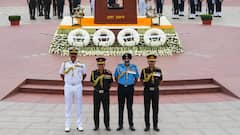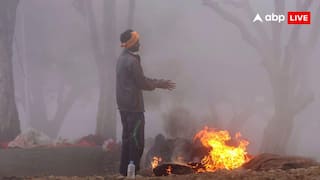Explorer
Gorkha Rifles: Indian Army's Daredevil Infantry Regiment Which Has Turned The Tide Of Many Battles With Famous Khukri Charge
The regiments of the Gorkhas Rifles collectively and more popularly known as the 'Gorkha Brigade', form a pivotal element of the Infantry (Combat Arm) of the Indian Army. Approximately 45000 Gurkhas serve in 40-odd battalions spread across 7 Gurkha Rifles regiments and other arms of the Indian Army.

Gurkha Rifles marching contingent (Image: Getty)
The long standing and deep ties between sub continent neighbours India and Nepal took a bit of an ugly turn as the nations were engaged in a stand-off over a border dispute which got triggered off on account of certain strategically located Indian occupied areas like Lipulekh Pass and Kalapani being claimed by the Nepalese govt via release of new maps.
It is a well known fact all over the world that India and Nepal share very strong and deep historic and cultural ties which date back to not years but centuries. The deepest ties between the two sub continent neighbours have been fostered via a long lasting military bond where much famed Gurkha troops of Nepalese domicile, known for their bravery and courage, have served in the Indian Army and made significant contributions in the nation's victories over its adversaries in the wars fought over seven decades since independence.
In this backdrop, it becomes imperative for each Indian citizen to understand the deep ties between India and Nepal and how the valiant Gurkhas troops from Nepal have done yeoman service to Indian Army with their exceptional track record in both field and peace
A General Background
Gorkha Rifles - One of Indian Army's Highly Acclaimed and Decorated Infantry Regiments The regiments of the Gorkhas Rifles collectively and more popularly known as the 'Gorkha Brigade', form a pivotal element of the Infantry (Combat Arm) of the Indian Army. Approximately 45000 Gurkhas serve in 40-odd battalions spread across 7 Gurkha Rifles regiments and other arms of the Indian Army.
The brave Gurkha soldiers have etched their names in the golden annals of Indian Army with almost all their regiments actively taking part in all of India's wars post independence, namely the Indo-Pak 1965 and 1971 Wars, 1962 Indo-China Conflict, 1999 Kargil War and peace keeping missions in Sri Lanka.
The Gurkha battalions showcased their undeterred spirit, Indomitable courage and valour at various battles, which earned them numerous battle and theatre honours - Gurais, Bilafond La, Shingo, Phillora, Dera Baba Nanak, Kargil, Bogra, Battalik to name a few ..
So here is a brief into the history of the Gorkha Rifles and their notable achievements Boys from the hills of Nepal who are trained, polished and refined by armies to become the consummate soldier ..Gurkhas.. The mere mention of the name Gurkhas / Gorkhas sends down chills in the spines of those who have fought them or faced them in various battle fronts all through the course of military warfare..
The bravado and valiance of the Gurkhas has become somewhat a folklore and finds a noteworthy place in military history.There could not be a more fearsome sight on the battlefield when the steadfast Gurkhas ferociously charging with their Khukris, curved blade knives, unleash sheer carnage into enemy territory slashing the throats of the enemies. The brave tales of the Gurkha soldier are stuff of legends and have earned them the title of the Bravest of the Brave. The regimental Motto of most of the Gurkha Rifles (GR) regiments say it all -Kayar Hunu Banda Marna Ramro (It Is Better To Die In War Than Live Like A Coward) Perhaps there isn't a better way to describe the valour and courage of the Gurkhas which came from none other than one of the finest ever military commanders, Field Marshal Sam Manekshaw. who had the privilege of serving with the Gurkhas during his stellar military career“If anyone tells you he is never afraid, he is a liar or he is a Gurkha.” - Field Marshal Sam Manekshaw. Born and raised amid the lofty mountain ranges of the Himalayan region in Nepal and India, the rugged terrain and the harsh climatic conditions of the highlands make the Gurkhas naturally adept to enduring all odds to survive till the very last bullet is fired in the battlefield. Stockily built with tremendous endurance and physical prowess, Gurkhas are tailor-made to excel as a lethal combat soldier.The Anglo Gurkha Wars And Raising Of Gurkha Rifles By The Britishers The British fought against the Gurkhas in the Anglo Gurkha Wars (Nov, 1814 – Mar, 1816), and though victorious , it left them impressed with the sheer resistance and tenacity of the fierce hillmen under their iconic military commander General Amar Bahadur Thapa. Much lesser in numbers, the Gurkhas inflicted some heavy damages on a much more formidable British Army, giving an exhibiting of their bravery. While the East India Company who were on an expansion mode, faced adversaries like the Sikhs, Afghans, Jats and Marathas, they envisaged a game changing strategy to recruit the ferocious Gurkhas into their army, thus marking the beginning and formation of the much famed Gurkha Rifles regiments. In 1815, The first battalion of the Gurkha Rifles regiment more popularly known as the 'Nasiri regiment' (later become 1st Gorkha Rifles) was raised.
The Gurkhas went onto become the most trusted, dependable fighting force spearheading successful campaigns in the Gurkha-Sikh War, Anglo-Sikh wars, Afghan wars and Indian's rebellion in 1857.
During the World Wars, the Gurkhas turned the tide of various battles fighting for the Commonwealth Armies, deep entrenched into the deadliest of battles in Falkland Islands, Africa, Cyprus, Mesopotamia, Rangoon to name a few . Fighting under the British flag, Gurkha regiment showcased exemplary bravery during the World Wars, earning 26 Victoria Crosses (the highest war time gallantry award accorded by the erstwhile British forces), the highest by any regiments under the British fold. The Tripartite Agreement Between India, Nepal and United Kingdom In 1947- Re-organisation and Formation of Gurkha Regiments Serving In Indian Army Post Independence When India's independence took place in 1947, a major decision had to be made with regards to the Gurkha regiments serving in the erstwhile British Army. So a Tripartite agreement was signed between India, United Kingdom and Nepal; resulting in the original ten Gurkha regiments being split between the British Army and the newly independent Indian Army. Out of the 10 Gurkha Rifles regiments, four were transferred to the British Army and six formed part of the post independence Indian army. The regiments to join the British Army were 2 GR, 6 GR, 7 GR, and 10 GR. The regiments which were transferred to Indian Army were 1 GR, 3 GR, 4 GR , 5 GR, 8 GR, 9 GR. Another Gorkha Rifles regiment was raised post independence from the volunteers (non-optees_ who did not wish to serve with the British Army , thereby raising the 11th Gorkha Rifles (11 GR).
*GR - Military Abbreviation In Short For Gorkha Rifles Gorkha Rifles Have Won Three Param Vir Chakras The Gorkha Rifles has the proud distinction of winning three Param Vir Chakras (PVC) with Captain GS Salaria (3/1 GR) posthumously, Subedar Major Dhan Singh Thapa (3/8 GR), Captain Manoj Kumar Pandey (1/11 GR, posthumously) being the proud recipients of the nation's highest gallantry award.
Gorkha Rifles Have The Unique Distinction of Producing Three Army Chiefs And One Field Marshal
The Gorkha Rifles have the honour of producing three Indian Army Chiefs. Former Army Chiefs - General SHFJ Manekshaw (Originally 12th Frontier Force Regiment later transferred to 8 GR), General Dalbir Singh (4/5 GR) and General Bipin Rawat (5/11 GR) were all commissioned into the Gurkha Rifles.
The 8th Gorkha Rifles has the unique distinction of producing one of the two Field Marshals of the Indian Army, Field Marshal Sam 'Bahadur' Manekshaw. General Bipin Rawat Appointed As Indian Army's First Chief Of Defence Staff
The Gorkha Rifles added another path breaking chapter in their glorious regimental history when General Bipin Rawat (Belongs To 5/11 Gorkha Rifles), was appointed as the first ever Chief of Defence Staff (CDS) of the Indian Army. Note: The article is based on the writer's opinion and research on the topic, it has no bearing whatsoever with the organisation's view and stand on the subject.
Related Video
Uttarakhand News: Winter Chill Grips North India; Kedarnath Dham Covered in Snow
Follow Breaking News on ABP Live for more latest stories and trending topics. Watch breaking news and top headlines online on ABP News LIVE TV
Top Headlines
India
Jammu and Kashmir
News
Cities

Justin M Bharucha
Opinion




































